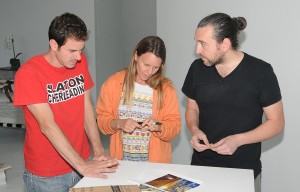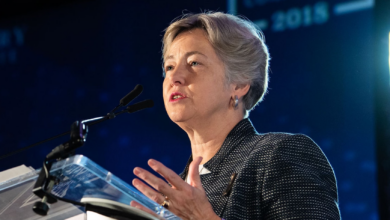Alan Bounville is a Man Moving Forward… And He Wants us to Come With Him
by Alex Grandstaff

Alan L. Bounville is currently traversing the nation in the name of ending gender discrimination. He uses skills honed in NYU’s Education Theater Program to educate and inspire audiences to action. Alan began his Into The Light Walk protest after realizing walking was “the most cost-effective way to open up conversations about gender, gender identity, gender expression and sexual orientation.”
Since May 2011, he has traveled over 2,700 miles on his 6,000-mile journey from Seattle to Washington DC to end gender discrimination. Along the way, he gives “theater of oppression” workshops and performances, educating people on why he’s making such an arduous journey.
Shelley Rice, co-owner of Houston’s Walking R granola distribution, brought Bounville to Houston after spotting him walking Highway 71 on his way to Austin. Last March, Alan performed his one-man, one-act play When People Lead at Simon Gentry’s Photobooth Gallery in Montrose, a photography studio and performance space with a special interest in artistic philanthropy.
The play interweaves Alan’s own account of how his activism changed his familial relationships with conversations he had with his stepmother and activists he’s met. As slide projections signal changes of person and subject, Alan seamlessly takes on the voice and mannerisms of each person as he recounts what drove them to action. Iana Di Bona, of Austin, became involved when she attended court proceedings for a protest Alan organized in New York. Louis Flores of Queens, New York, was driven to action when he realized his closeted life separated him from his family. He regretted not having a closer relationship with his gay brother before he died of AIDS.

The last account Alan gives is of Toby Grace, an older white gay man from Trenton, New Jersey. Grace recalls how his partner Norman, who died of AIDS in 1995, was repeatedly denied apartments because of he was African-American. When one landlord used a racial slur, Norman, a shaman, sent the man love rather than anger and hatred, saying that’s what he needed. Toby also recalled his 1969 transformation on the morning after the Stonewall riots, when he found Christopher Street deserted except for one man sweeping the streets singing “Somewhere” from West Side Story. “There’s a place for us” stayed with him. Alan expands on the song in his performance, saying that somewhere there is a place for us, and that place is here and our time is now.
The performance ends with Alan recounting the emotion of the second Die-In he organized in New York’s Grand Central Station. Cued by Alan’s piercing whistle, Die-In protestors dropped to the floor as if struck dead, crying out the names of LGBT people who were killed or committed suicide due to discrimination based on their sexuality or gender identity. Alan’s voice cracked as he shouted names as images of the protest and photos of those lost rotated on the screen behind him.
Alan remains angry that in 2012 we still lack equality—and that anger has driven him to action. This is a man who has lost the ability to sit still and instead chooses to move forward across the nation, calling out to everyone to join him in working for justice.
To follow Alan’s progress visit: www.intothelightwalk.com
To help fund Alan Bounville’s journey, with a tax deductible donations: https://www.fracturedatlas.org/site/contribute/donate/4143.
Editor’s note: A correction to this story was made on 4/17/12.










